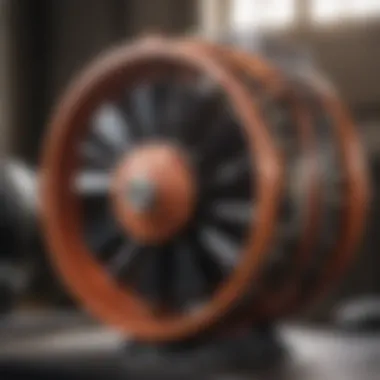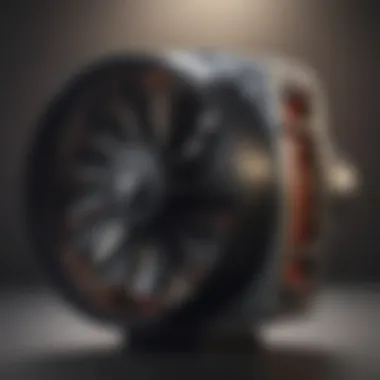Understanding Small Fan Motors in Agriculture


Overview of the Topic
Definition and Importance
Small fan motors are essential components in various agricultural and horticultural applications. These motors drive fans that circulate air, ensuring adequate ventilation and temperature control in environments crucial for plant growth. Understanding their construction and operation is vital for professionals in the field. They can significantly influence crop yields and overall operational efficiency.
Importantly, the small fan motor functions as the muscle behind essential systems like greenhouses, livestock barns, and storage facilities. Without these motors, it would be challenging to maintain optimal conditions for plants and animals.
Current Trends
Recent developments in small fan motor technology focus on energy efficiency and sustainability. Many manufacturers are integrating advanced materials and designs to enhance performance while reducing energy consumption. Trends indicate a switch towards brushless DC motors, which provide higher efficiency rates, longer life cycles, and lower noise levels compared to traditional options. Additionally, IoT connectivity is becoming more common, allowing for improved monitoring and management of environmental conditions.
Key Techniques and Practices
Step-by-Step Guide
- Assess Requirements: Determine the specific airflow and ventilation needed for your application.
- Select Motor Type: Choose an appropriate small fan motor type based on efficiency and noise requirements.
- Installation: Properly install the motor ensuring secure attachments and alignment.
- Wiring and Safety: Follow electrical codes while wiring to ensure safety.
- Testing: Conduct thorough testing to confirm that the system operates effectively under various conditions.
Tools and Equipment Needed
- Small fan motor (e.g., Dayton or Fasco)
- Mounting brackets
- Electrical tools (screwdriver, wire cutter, multimeter)
- Safety gear (gloves, goggles)
Challenges and Solutions
Common Obstacles
Maintaining consistent performance in small fan motors can be hindered by obstacles such as dust accumulation, inadequate power supply, and external temperature variations. These factors can lead to energy inefficiency and potential malfunctions.
Innovative Solutions
To address these challenges, regular maintenance is key. Implementing a cleaning schedule can mitigate dust and debris issues. Upgrading to energy-efficient designs will reduce power consumption, maximizing performance.
Overall, embracing modern technology within small fan motors, combined with mindful maintenance practices, will enhance productivity and sustainability across agricultural sectors.
"The integration of IoT technology in motor controls leads to significant improvements in system adaptability and monitoring."
An in-depth understanding of small fan motors can help farmers and horticulturists increase their operational efficiency while contributing to sustainable practices in agriculture. For more detailed information and insights, you can explore resources on Wikipedia or Britannica.
Preface to Small Fan Motors
Understanding small fan motors is essential for anyone involved in agriculture and horticulture. These motors play a vital role in various applications, enhancing productivity and ensuring optimal conditions for growing plants. Their design and function contribute greatly to the efficiency of systems that rely on air circulation, cooling, and temperature management.
Small fan motors are machines that convert electrical energy into mechanical energy to produce airflow. They consist of several key components that allow them to function effectively. Recognizing these components provides a foundation for appreciating their applications.
The benefits of utilizing small fan motors extend beyond mere airflow. Their integration can lead to significant energy savings, improved plant health, and consistent climatic conditions in controlled environments. Understanding these aspects is crucial for professionals seeking to optimize their agricultural practices.
The section first defines small fan motors and explains their purpose. It then discusses their importance within agriculture and horticulture, focusing on the specific needs and benefits that come with their implementation.
Definition and Purpose
Small fan motors are compact devices designed to generate airflow for various applications. Their primary function is to move air, which is essential in maintaining suitable environmental conditions for plant growth. These motors are typically characterized by their size, efficiency, and versatility, making them suitable for a wide range of applications.
The purpose of small fan motors goes beyond simple air distribution. In agriculture, they regulate temperature and humidity in greenhouses, enhance ventilation in livestock housing, and aid in the drying process of harvested crops. The selection of a specific type of motor depends on the required performance, energy efficiency, and cost considerations.
Importance in Agriculture and Horticulture
The significance of small fan motors in agriculture and horticulture cannot be overstated. They provide essential mechanisms for creating optimal growth environments, directly influencing the health and yield of crops.
- Ventilation Systems: In greenhouses, proper ventilation is crucial. Small fan motors improve the circulation of air, helping to control temperature and humidity levels.
- Cooling in Greenhouses: During hot weather, small fan motors facilitate cooling systems, preventing stress on plants and ensuring that they thrive.
- Pollination Assistance: In some settings, small fan motors can assist in pollination by simulating wind movements, aiding in the natural pollination processes of flowering plants.
"Implementing small fan motors can lead to improved airflow management, which is essential for optimizing plant growth."
Components of Small Fan Motors
The components of small fan motors are critical in determining their functionality and performance. By understanding these components, users can make informed decisions about the motors they choose for agricultural and horticultural applications. Each component contributes uniquely, affecting the overall efficiency and reliability of the motor.
Electric Motor Basics


Electric motors operate on the principles of electromagnetism. They convert electrical energy into mechanical energy, which ultimately drives the fan blades. The core parts of an electric motor include the stator, rotor, and winding.
- Stator: This part is stationary and provides a magnetic field.
- Rotor: This part rotates within the stator and is crucial for generating airflow.
- Windings: These are coils of wire wrapped around the stator, creating the necessary magnetic field when electric current passes through them.
The efficiency of small fan motors largely depends on the quality of these components. Motors designed with precise manufacturing standards can operate with less energy, which is vital in settings where power consumption is a concern.
Fan Blade Design and Materials
The design and materials used for fan blades are fundamental in determining airflow performance. Different shapes can affect how air is moved and how much noise is generated. Key considerations include:
- Shape: Blades can be straight or curved. Curved blades typically provide better airflow.
- Material: Common materials for fan blades include plastic, metal, or composite materials. Each material has its advantages and disadvantages, particularly in terms of weight and durability.
For example, plastic blades are lighter and may be less costly, while metal blades offer stronger durability. The choice of material often reflects the intended application of the motor.
Housing and Support Structure
The housing protects the internal components of the small fan motor. It ensures durability and can also have thermal management properties.
- Material: Often made from metal or high-grade plastic, the material can impact heat dissipation and overall life span of the motor.
- Cooling Vents: Proper ventilation in the housing design helps manage overheating, which is critical for maintaining performance.
The support structure should maintain stability, especially in environments with vibrations. A well-designed housing not only prolongs the life of the motor but also contributes to its efficiency and operational quality.
"Understanding these components helps users identify suitable motors for specific applications, significantly influencing overall system performance."
Investing time to comprehend the intricacies of small fan motor components is essential for optimizing their use in agriculture and horticulture. With proper selection and maintenance, these motors can greatly enhance productivity and operational efficiency.
Operation Principles of Small Fan Motors
Understanding the operation principles of small fan motors is crucial for several reasons. These motors serve as the backbone of many agricultural and horticultural applications. Their functioning directly influences efficiency, reliability, and performance. By grasping the fundamental principles that govern their operation, farmers and horticulturists can make informed decisions regarding the selection and maintenance of these essential tools. This section will delve into key electrical principles, airflow mechanics, and thermal management, all of which contribute to the successful operation of small fan motors.
Basic Electrical Principles
At the core of small fan motors lies the interplay of electricity and magnetism. Small fan motors typically operate on either Alternating Current (AC) or Direct Current (DC). Each type of motor converts electrical energy into mechanical energy through magnetic fields.
In AC motors, the alternating current creates a magnetic field that rotates within the motor. This rotation drives the fan blades, generating airflow. Conversely, DC motors work on a different principle, where the direct current creates a consistent magnetic field. This enables more precise control of speed and torque, which is particularly advantageous in applications that demand variable speed settings.
Additionally, understanding the electrical requirements of these motors is critical. Proper voltage and current ratings ensure efficient operation without overheating or damaging the components.
Mechanics of Airflow Generation
The mechanics involved in generating airflow are paramount in small fan motors. The design of the blades is crucial, as it can significantly affect airflow efficiency and volume. Fans can have different shapes and sizes depending on their intended use. For example, a fan designed for greenhouse ventilation may have wider blades to push more air, while one intended for precision cooling might have narrower blades.
The rotation of the blades creates a pressure differential. This differential pulls air from one side and expels it from another. The speed at which blades rotate directly influences the volume of air moved. An increase in rotational speed will typically produce a proportional increase in airflow.
Furthermore, it is important to consider the positioning of the fan. The fan should be placed in an area where it can effectively direct airflow across plants or equipment needing ventilation or cooling.
Thermal Management
Thermal management is a critical aspect of small fan motor operation. Motors generate heat during operation due to electrical resistance and mechanical friction. Managing this heat is vital for maintaining performance and extending the life of the motor.
Proper thermal management strategies include:
- Ventilation: Ensuring that the motor is adequately ventilated can prevent overheating.
- Heat sinks: Adding heat sinks can help dissipate heat away from the motor body.
- Regular maintenance: Checking for dust and debris that may impede airflow keeps components cool.
Managing heat is especially important in high-performance applications. Motors that operate under extreme conditions need additional cooling to ensure reliability.
"The efficient operation of small fan motors is fundamentally linked to the principles of electricity, airflow mechanics, and effective thermal management."
Types of Small Fan Motors
Understanding the types of small fan motors is essential for both practical applications and forward-thinking in the agricultural and horticultural space. Each motor type has unique benefits and operational considerations that determine their suitability for various tasks. Selecting the right small fan motor can significantly enhance efficiency, optimize performance, and contribute to better environmental practices in farming and gardening.
AC vs. Motors
AC motors operate on alternating current, while DC motors use direct current. The choice between these two types can be important, depending on the specific needs of a system.
Benefits of AC Motors:


- Usually more reliable for continuous operation.
- Generally designed to handle larger loads.
- Commonly used in permanent installations such as ventilation systems in barns.
Benefits of Motors:
- Better for variable speed applications.
- Often lighter and more compact, making them suitable for smaller setups.
- Typically offer higher starting torque, which is useful in specific horticultural tasks like circulation and aeration.
Brushless vs. Brushed Designs
In small fan motors, the distinction between brushless and brushed designs can determine the maintenance requirements and overall efficiency. Brushless motors utilize electronic commutation, eliminating the wear and tear associated with brush components.
Advantages of Brushless Motors:
- Higher efficiency, translating to lower energy consumption.
- Longer lifespan due to reduced mechanical wear.
- Quieter operation, which creates a more pleasant working environment.
Advantages of Brushed Motors:
- Simplicity in design, making them often more affordable.
- Easier to control, which can be a benefit in certain applications.
- Generally sufficient for tasks that do not require prolonged usage or high reliability.
Variable Speed Motors
Variable speed motors offer the flexibility to adjust the speed of the fan according to real-time needs. This capability enhances the efficiency of both cooling and ventilation systems in diverse agricultural environments.
Key Considerations for Variable Speed Motors:
- Ability to adapt to varying environmental conditions, such as temperature fluctuatuions.
- Improved energy savings by operating at the most efficient speed.
- Enhanced control over airflow for specific tasks like pollination assistance or maintaining optimal conditions in hydroponics.
Applications of Small Fan Motors in Agriculture
Small fan motors play a pivotal role in agricultural practices. Their applications range from air movement to temperature regulation in various systems. Understanding these applications is essential. Farmers and hobbyists can optimize their operations and enhance productivity by utilizing small fan motors effectively.
Ventilation Systems
Ventilation systems in agriculture are crucial for maintaining optimal conditions in growing environments. These systems ensure that airflow is adequate to prevent heat buildup and humidity issues. Small fan motors are at the heart of these systems, powering exhaust fans and intake ventilators.
The benefits of effective ventilation cannot be overstated. Proper airflow minimizes the risk of diseases caused by stagnant air. It also helps control pests by creating an environment less favorable for them. Moreover, adequate ventilation can enhance the growth of plants by ensuring they receive a consistent supply of fresh air. Using efficient small fan motors can significantly reduce energy costs, thereby making operations more sustainable.
Cooling in Greenhouses
Greenhouses benefit greatly from small fan motors, especially for temperature control. High temperatures can jeopardize crops, leading to wilting and stress. Small fan motors drive cooling fans that exhaust hot air and maintain a conducive climate for plant growth.
Efficient cooling systems powered by durable small fan motors can improve crop yield and quality. When temperatures rise, plants require careful monitoring. Rapid adjustments can be made with focused cooling strategies to sustain ideal conditions. Additionally, integrating temperature sensors with small fan motors enhances automation, ensuring optimal performance with minimal staff involvement.
Pollination Assistance
Pollination is vital for crop production, and small fan motors contribute to this process through their role in setting up controlled airflow. In many cases, pollination is not solely dependent on insects. Artificial assistance using fans can facilitate the movement of pollen between flowers. This technique can increase fruit set and improve yield.
Moreover, small fan motors help simulate natural breezes, which can encourage healthier plant growth while stimulating the pollination process. In systems like hydroponics, where insect access is limited, small fan motors become integral to ensure that pollination occurs effectively.
"Small fan motors optimize essential practices in agriculture, enhancing both yield and sustainability."
Small Fan Motors in Horticulture Practices
Small fan motors play an essential role in horticulture, providing critical support in areas such as ventilation, humidity control, and overall environmental management. The integration of these motors in various horticultural practices helps to optimize growing conditions, promote healthy plant development, and increase crop yields. As agricultural technology advances, so too does the reliance on small fan motors in modern horticulture.
Hydroponics and Aeroponics
In hydroponic and aeroponic systems, small fan motors are fundamental for maintaining air circulation and providing the necessary oxygen to the roots of plants. Air circulation not only helps in avoiding stagnation but also supports even nutrient distribution, which is vital for optimal plant growth. Moreover, these motors assist in regulating temperature and humidity levels, which can otherwise lead to root rot or fungal growth.
Efficient air movement can be achieved by utilizing different fan blade designs tailored to specific setups, ensuring that airflow reaches all parts of the growing area. The motors used in this context need to operate quietly and efficiently, often with variable speed options. This flexibility allows growers to adapt to changing environmental conditions comfortably.
Propagation Environments
Propagation of plants through cuttings, seeds, or tissue culture demands precise environmental control. Small fan motors contribute significantly to this process by ensuring consistent airflow in propagation chambers. Proper circulation helps maintain even temperatures and humidity levels, which are crucial for seed germination and rooting cuttings.
In these environments, stagnant air can lead to disease outbreaks or poor growth rates. Consequently, the integration of small fan motors helps sustain healthy microclimates conducive to propagation success. It is essential for growers to regularly check and maintain these motors to prevent any malfunction that might disrupt delicate propagation processes.
Environmental Control Systems


Small fan motors are vital components in various environmental control systems employed in horticulture. These systems aim to create optimal conditions for plant growth, encompassing temperature, humidity, and overall air quality management. By incorporating small fan motors in automated systems, growers can ensure that environmental parameters remain within desired ranges, enhancing the growth potential of the plants.
These systems often include sensors and controllers that monitor conditions and adjust fan operation accordingly. This automated approach minimizes manual intervention and maximizes efficiency. The ability to seamlessly integrate technology with small fan motors is crucial for forward-thinking horticultural practices.
The use of small fan motors is no longer merely an auxiliary option in horticulture; they have become integral to the success of modern growing techniques.
Maintenance of Small Fan Motors
Maintaining small fan motors is essential for ensuring their longevity and efficiency in various applications within agriculture and horticulture. Regular maintenance reduces the risk of unexpected failures, thus minimizing downtime and repair costs. A well-maintained fan motor can significantly improve airflow effectiveness, which is crucial for plant growth and health. Additionally, maintenance practices can also contribute to energy efficiency, reducing operational costs over time.
Routine Checks and Cleaning
Routine checks and cleaning of small fan motors should be a regular part of any maintenance schedule. These checks can help identify potential issues before they become significant problems. Regular inspection of motor components such as the fan blades, housing, and electrical connections is important. Here are some aspects to consider:
- Visual Inspection: Look for signs of wear, corrosion, or damage.
- Dust and Debris Removal: Keeping the motor clean from dust buildup ensures optimal performance.
- Lubrication: Components with moving parts, like bearings, should be lubricated to prevent friction and overheating.
Cleaning can be done using a soft brush or compressed air to blow away contaminants. Ensuring that vents are clear helps in maintaining proper airflow, which is critical for cooling the motor and preventing overheating.
Troubleshooting Common Issues
Even with regular maintenance, issues can arise. Knowing how to troubleshoot common problems can save time and enhance efficiency. Here are some typical issues you might encounter:
- Unusual Noises: Grinding or squealing noises often indicate that something is wrong with the bearings.
- Reduced Airflow: This could be due to debris clogging the fan blades or an electrical issue.
- Motor Not Starting: Check electrical connections, switches, and the power source.
In case the motor shows any faults, do not ignore them. Addressing these issues promptly can prevent further damage and ensure reliable operation.
Replacement and Upgrades
At some point, maintenance may involve replacement or upgrades of components. Replacing worn-out parts, such as fan blades or bearings, can restore the motor's efficiency. Upgrading to newer, more energy-efficient models may also be beneficial. When considering replacements or upgrades, think about the following:
- Compatibility: Ensure that new parts are compatible with the existing motor.
- Performance Improvements: Look for motors with better energy ratings or features suited for specific applications.
- Cost-Benefit Analysis: Compare the costs of maintenance versus replacement or upgrade to determine the best option.
An investment in regular maintenance translates to improved performance and longevity of small fan motors, which are critical for agricultural applications.
By paying attention to these maintenance aspects, farmers and horticulturists can ensure their small fan motors operate effectively, thus optimizing productivity within their farms and greenhouses.
Future Trends in Small Fan Motor Technology
The landscape of small fan motors is evolving at a rapid pace. With advancements in technology and increasing environmental awareness, new trends are shaping the future of these essential components in agriculture and horticulture. This section explores energy efficiency improvements, smart technology integration, and the development of sustainable materials, highlighting how these trends will impact applications and overall effectiveness.
Energy Efficiency Improvements
Energy efficiency is becoming a focal point in the design and operation of small fan motors. As energy costs continue to rise, the demand for motors that consume less energy while providing the same or better performance has increased.
- Benefits of Energy Efficiency: Minimizing energy consumption lowers operational costs for farmers and horticulturists. It also reduces the carbon footprint associated with energy production, aligning with global sustainability goals.
- Technological Innovations: Innovations such as improved motor designs, better materials, and integration of variable speed drives help enhance efficiency. These technologies enable motors to adjust their performance based on real-time needs, preventing energy waste.
- Regulatory Compliance: Meeting energy efficiency standards can also be a requirement for certain subsidies and programs aimed at promoting sustainable practices, making compliance a financial advantage.
Smart Technology Integration
The integration of smart technologies in small fan motors represents another significant trend. This includes the application of Internet of Things (IoT) principles, leading to smarter and more responsive systems.
- Remote Monitoring: Farmers can now monitor their fan motors remotely, allowing for real-time data collection and analysis. This aids in making informed decisions about operations and maintenance.
- Automation: Many small fan motors can now be automated. For example, systems can be programmed to turn on or off based on temperature sensors or humidity levels, resulting in optimized performance.
- Data Analytics: The ability to gather and analyze data from these motors can help improve overall agricultural practices. Patterns in energy use, performance, and maintenance needs can be tracked, leading to enhanced operational strategies.
Sustainable Materials Development
Sustainability is at the heart of many technological advancements. The usage of sustainable materials in the construction of small fan motors is gaining traction and offers numerous advantages.
- Eco-Friendly Alternatives: Manufacturers are exploring biodegradable and recyclable materials. This reduces reliance on non-renewable resources and minimizes waste in the supply chain.
- Durability and Longevity: Sustainable materials often enhance the durability and lifespan of fan motors. Improved longevity translates to fewer replacements, thus reducing environmental impact.
- Consumer Preferences: As consumers grow more environmentally conscious, the demand for sustainable products increases. Companies adopting eco-friendly practices may foster brand loyalty among this discerning group.
Closure
In this article, we have explored the multifaceted applications and insights of small fan motors, which play a vital role in various agricultural and horticultural sectors. The importance of small fan motors extends beyond mere mechanical function; they are fundamental to enhancing productivity, sustainability, and efficiency in these industries.
Summarizing Key Points
To summarize, small fan motors facilitate critical processes such as ventilation, cooling, and pollination. These motors are designed with unique features that allow them to operate effectively in challenging environments, ensuring stability and durability. The distinction between AC and DC motors, along with brushed and brushless designs, showcases the range of options available for different applications. Additionally, energy efficiency and smart technology integration are emerging trends that promise to further enhance the functionality of these motors in agricultural practices.
The Importance of Small Fan Motors in Modern Practices
The relevance of small fan motors in modern practices cannot be overstated. They assist in maintaining optimal growing conditions, crucial for maximizing crop yields. Moreover, their adaptability makes them suitable for a variety of setups, from traditional greenhouse environments to advanced hydroponics systems.
Investing in quality small fan motors means committing to improved performance and sustainability. With ongoing advancements in technology, the future of small fan motors looks promising, offering more efficient and environmentally friendly solutions for the agriculture sector.
"Incorporating advanced small fan motors can directly influence productivity and minimize environmental impact, leading to more sustainable farming practices."
Overall, understanding the intricacies of small fan motors empowers farmers and industry professionals to make informed decisions, ultimately benefiting their operations and contributing to broader sustainability goals.



